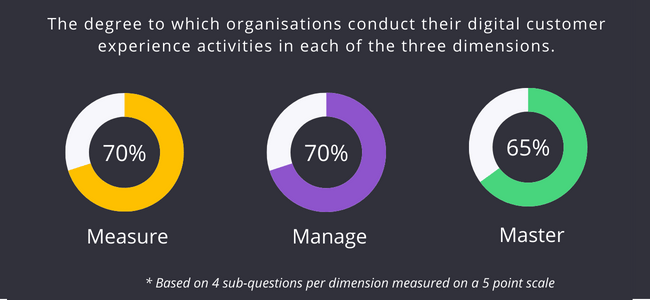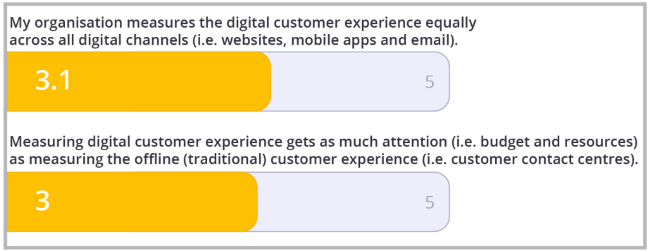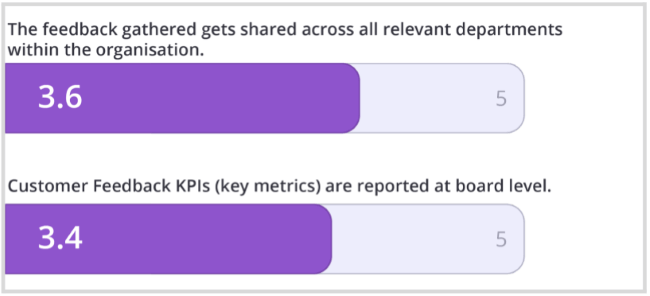A few weeks ago, we released the Digital CX Management Benchmark report 2023, and it’s packed with some pretty interesting findings. The report has left us with some thought-provoking questions, such as: Why are businesses investing more resources in traditional CX instead of Digital CX? Why does measuring and managing feedback get more attention than mastering feedback? Or why are there big differences between industries in managing digital CX? We turned to the experts to help us answer these questions and asked them to share their perspective on the outcomes of the Benchmark.
In this article, we will go over the results from the Benchmark report and ask experts to respond to the most interesting findings. Experts active in the field of CX, digital marketing, and marketing analytics share their insights on CX Management and predict the future of Digital CX.
- Measure, Manage and Master Digital CX
- Measuring CX equally across all channels
- Reporting feedback data across the organisation
- Mastering Digital CX Management
- General reaction
- Future of digital CX
Measure, manage and master Digital CX
The Benchmark measures the level of activity of companies around digital CX Management along three dimensions: Measure, Manage and Master.
The Measure phase measures how organisations collect feedback on their digital channels.
The Manage phase measures how organisations analyse and report the incoming feedback.
The Master phase measures how organisations take action based on feedback.
We conducted a survey-research, where participants had to rate their level of agreement to 4 statements per dimension along a 5-point Likert scale. Total scores were calculated by adding the points and dividing them by the maximum points that could be given, providing us a percentage that shows how successful companies are with their digital CX management.
Below, you see the scores that were given for each dimension. We see that the Measure and Manage phase both have a score of 70%, while the Master phase has a score of 65%. It seems that the average score for all three dimensions is really quite decent, and that many organisations collect feedback, analyse feedback and report it to their team or board. Using feedback to make improvements and discussing feedback with relevant stakeholder, the Master phase, is lacking a little behind the other phases. We turned to the experts to explain these scores.

What do the experts have to say?
We start with expert Dimitry Patoir for his take on the matter. Dimitry works as Senior Customer Experience Manager at Kantar, one of the world’s leading marketing data and analytics company.

Q: Many companies give a higher score to Measuring and Managing CX data than to Mastering CX data. Why do you think that is? And how can companies do more with taking action on CX data?
Dimitry Patoir: “I think it shows the level of maturity of an organisation in the field of Customer Experience. Typically, you first start with measuring, and then proceed to analyse and report what your customers tell you. The next step, ensuring a swift follow-up (Master) is more challenging for many organisations. Where the first steps can be done with a relatively small group of people, this last step requires involving the entire organisation. This is often more difficult.”
“The good news is that the increasing availability of software that can support this. These CX platforms not only collect and analyse customer feedback, but through a ticketing system also facilitate the follow-up of this feedback. The challenge to embed CX ownership in the organisation is still very real though: you need a core team to drive customer-centric thinking throughout the organisation, and CX heroes within each different department to ensure adoption. Software can help with this, but it starts with a clear strategy and buy-in from crucial stakeholders.”
Next, we asked the same question to Kelsey Balimtas. Kelsey is a Global Manager Customer Experience at HubSpot. HubSpot is a market leading CRM platform for marketing, sales and customer service.

Kelsey Balimtas: “Mastering CX Data requires a real-time listening engine and the organisation of data to offer real-time insights. It’s challenging! Further, mastering CX Data also requires CX governance, a structured approach to soliciting, responding, and taking action on data. Successful CX governance requires buy-in and ongoing engagement from across the organisation, something many organisations struggle to achieve. One of the first steps companies can take to better action CX data is to create governing structures that create space for CX alignment, collaboration, and accountability. An executive sponsor for CX strategy (e.g., a CCO or other leader) can help drive this alignment and action.”
Note! Mopinion recently released Access Groups, which helps you manage feedback effectively across the organisation and make sure different teams can benefit from feedback.
Measuring CX equally across all channels
Next, we’ll look into the Measure phase, as some of the findings require further clarification. In the image below, we see that the score for measuring digital Customer Experience equally across all digital channels is 62%. We also see a score of 60% for giving digital CX measurements as much attention as offline (traditional) CX. Why is digital CX not measured equally across all digital channels? And why is measuring traditional CX getting more budget and resources allocated than digital CX?

The scores for two subthemes in the Measure phase
What do the experts have to say?
We asked Elysa van der Graaf to share her thoughts on the topic. Elysa works as SEO specialist and CRO Lead at Maatwerk Online, a full-service online marketing agency from the Netherlands.

Q: Digital CX is not measured equally across all digital channels. There is more attention to measuring CX on websites than on apps or emails. What do you think could be the reason for that?
Elysa van der Graaf: “I think that there are several reasons. First, websites are the most common customer touchpoint where most of the interactions happen. So it makes sense to focus on measuring CX there. Besides that, I believe that most companies aren’t capable of measuring UX on other channels. Websites have been around for much longer than apps or emails, and therefore offer a lot more opportunities for tracking and analysing customer behaviour. Measuring CX on apps and emails can be more challenging due to the lack of standardization and the limited availability of metrics and tools. Additionally, companies find it difficult to collect and analyse the right data to measure CX mostly due to lack of knowledge about goals and KPI’s, especially on relatively new channels. Last, companies may prioritize measuring CX on websites over other channels, due to budget constraints or resource limitations.”
Next, we asked Annette Franz. Annette is the Founder and CEO at CX Journey, a global CX strategy consultancy, helping other organisations become more customer-centric.

Q: Digital CX is not measured equally across all digital channels. Is there a reason for this?
Annette Franz: “There may be other reasons, but the main one that comes to mind first is that different channels have different owners. This inhibits the ability to create that omnichannel experience, and it’s problematic for customers and their experience. Different owners mean that there’s a need for a Chief Customer Officer to unite the departments, channels, and the vision across the organisation. Without someone stepping back to look at the big/full picture, feedback and measurements often happen in a vacuum.”
We also want to know why traditional CX is often still getting more attention than digital CX. So we asked CX Expert Jim Tincher. Jim is CEO at Heart of the Customer, a Customer Journey Mapping consultancy that helps other organisations improve their Customer Experience.

Q: Why is traditional CX often still getting more attention than digital CX?
Jim Tincher: “Few from customer experience come from a digital background, which leads the programs to focus more on traditional CX measurement. Our research into the state of Customer Experience programs (documented in my book) discovered that, while there are some more mature programs, the vast majority of CX programs inadvertently create their own silos, measuring the customer experience in traditional ways. This current state focus puts digital in a secondary role, leaders are starting to understand that digital is a critical channel to understand and are starting to build stronger listening posts to understand these interactions. These leaders start by understanding their company’s business problems – and digital transformation is on every leader’s agenda.”
It’s not uncommon for organisations to face challenges in delivering a smooth and consistent customer experience across various communication channels, which often results in incomplete CX data collection across these channels. How important is it really to measure CX on all channels?
Q: Should you incorporate CX measurements in all your campaigns and channels?
Elysa van der Graaf: “Nowadays, customers interact with businesses in different ways. Each channel offers a unique experience that can impact their overall perception of the business. An omnichannel CX measurement approach helps businesses to stay competitive by offering seamless and consistent experiences across all channels. CX measurements really gives you a holistic view on your customers’ experiences and helps identify crucial areas for improvement. Besides that, it helps you measure the effectiveness of your campaigns and channels. Especially because nowadays, a lot of campaigns work with algorithms (e.g. Google smart bidding). Using CX measurement is therefore key to improving your marketing efforts.”
Online Feedback for all channels
Mopinion lets you collect customer feedback on your website, app and emails. Learn how collecting feedback on all digital channels benefits your organisation.
Reporting feedback data across the organisation
Next, we’ll be looking at the findings from the Manage Phase. The results show that sharing feedback across all relevant departments (score = 72%) and reporting Customer Feedback KPI’s at the board level (score = 68%) is done quite frequently. Although the scores are relatively good, there is still room for improvements, and we aim to identify the reasons behind it.

The scores for two subthemes in the Manage phase
What do the experts have to say?
Q: Why is CX data not always shared across all relevant departments?
Dimitry Patoir (Kantar): “Some clients still struggle with the question of who is responsible for CX. Too often, everyone feels customer experience is important, but at the same time feels someone else should take the lead. And this is exactly what frustrates customers: when a customer has a problem, (s)he just wants the issue to be resolved. It doesn’t matter to them where it’s customer service, account management or the invoicing team that needs to do something, they just want a quick solution of their problem. In the end, all teams within an organisation have an impact on the customer experience: from digital teams to customer service and from marketing to HR.”
We also asked about the importance of reporting CX metrics at board level.
Q: How important is it that CX metrics get reported to the board level?
Dimitry Patoir: “Organisations that aim to be truly customer-centric, must do this across the entire organisation. It means thinking from the client’s perspective instead from each individual department. And that starts with the top: if the board is unable to think cross-silo’s and put the customer first, what can you expect from the employees in the layers below? That is why reporting and discussing CX-data on board level is crucial.”
Jim Tincher (Heart of the Customer): “It is critical that senior leadership understands the current state of the experience. When we analyse organisations that are able to differentiate through CX, they have far stronger governance and change management than other organisations. If leadership doesn’t understand the current experience, they can’t fund or prioritize efforts to improve it. Start with the financial outcomes listed above, then incorporate the behavioural data, and use the surveys to explain why those outcomes are that way.”
Mastering Digital CX Management?
As described earlier, the Master phase is just lacking a little bit behind from the Measuring and Managing phase. On a positive note, the scores in the Master phase are looking pretty good, with an average of 65%. We see that many organisations have recurring meetings with relevant stakeholders to discuss digital customer feedback (score = 72%), but that customer feedback isn’t always followed up in 48 hours (score is 52%). Thanks to the experts, we already have quite a clear picture of why Mastering Digital CX management is challenging. So instead, we asked the experts head on how this can be improved.

The scores for four subthemes in the Master phase
Can the experts give advice on how to improve the scores in the Master phase?
We first asked Stephan van Slooten, Managing Partner at Altuïtion. Altuïtion is a leading Customer and Employee Experience Consultancy from the Netherlands.

Q: How can companies set-up cross-organisational CX initiatives?
Stephan van Slooten: “It is very important to connect CX on a strategic level. You need a very clear vision of what you stand for as an organisation. For example, with clear KPI’s and clear ways to measure these key metrics, you can bring everything together. The customer journey and experience can become an integrated part of the organisation.”
“A few organisations now have someone who is responsible for CX at the highest level of the organisation. That’s one of the highest levels of CX maturity a company can reach. But that’s certainly not the case in all organisations yet.”
Kelsey Balimtas (Hubspot): “One of the most important aspects when democratizing CX data is making metrics relevant and accessible to stakeholders. Often, CX departments or practitioners will focus too heavily on crafting reporting suiting their own interests or measure sentiment in a vacuum. For example, CSAT is an important CX metric, but a business leader in a Customer Support function will care more about CSAT if you contextualize how CSAT impacts broader business goals like customer retention. At HubSpot, we embed CX metrics like CSAT in broader business dashboards to help our stakeholders better understand correlation and see all relevant metrics together — including CX metrics.”
We also want to know more about strategies companies can implement to act on real-time CX data. As this particular subtheme had the lowest score among all themes, some refreshing insights into this subject are greatly appreciated.
Q: How feasible is it for companies to make improvements in real-time and circle it back to the customer?
Stephan van Slooten (Altuïtion): “With many different sources bringing in CX data, it is important to interpret what is actually being said. Not everything can be fixed in real-time, and it would make an organisation less credible if they make claims that are (too) hard to deliver on. However, when a customer, for example, makes a complaint, it’s very important to instantly react and communicate that you are aware of their complaint and are trying to fix it immediately. This already takes a few 3/4th of the complaint. But that doesn’t mean you can fix things instantly.”
Annette Franz (CX Journey): “It depends on the issue, but certainly through a process called service recovery, there are things that brands can do to make immediate amends. Service recovery refers to the actions that brands take to rectify a customer’s negative experience. It’s the process of addressing a customer’s complaint or issue and providing a solution that meets or exceeds their expectations. Effective service recovery can help to build customer loyalty and improve customer satisfaction, as it shows that the organisation values its customers and is committed to providing high-quality service. As with anything else, it’s a process that must be formalized and operationalized. It must be a part of “the way we do things around here.”
General reaction
The insights provided by experts have allowed us to gain a better understanding of the strategies that organisations can implement to enhance their Digital CX Management. In addition, we are curious about their overall response to the Benchmark report, as certain findings may surprise them as well.
First, three experts from Mopinion also have something to say about the results from the Benchmark. Watch the video to see what that is.
Get the full (free) report here.
After hearing from our internal experts, it’s time to seek input from our external experts.
Q: What do you think of the results from the Benchmark? Did any of the outcomes surprise you?
Jim Tincher (Heart of the Customer): “Unfortunately, they don’t. Your summary on page 12 shows that the vast majority of programs are failing to drive change, almost exactly the same outcome as our research showed. The good news is that 1 in 4 programs are Change Makers!”
Dimitry Patoir (Kantar): “It is very much in line with what we see each day: organisations are making progress, but still struggle to overcome silo-thinking within their organisation. This impedes ensuring a swift follow-up on customer feedback. At the same time, the expectations of customers are increasing when it comes to CX. Especially on digital channels, customers base their expectations on all digital interactions they have, not just the interactions they have with the organisation itself or its direct competitors. Or, to put it simply: your experience when using the Uber app also influences your expectations when using the app of your telco-provider. At any rate, it is encouraging to see that 76% of the organisations surveyed reports that they are successfully improving the digital CX!”
Kelsey Balimtas (Hubspot): “I was surprised how many organisations felt they were “fairly successful” in improving digital customer experience. Measuring this improvement can be challenging, and I would be curious how these organisations are defining success.”
Annette Franz (CX Journey): “I think the biggest thing that surprises me is that people think of digital CX as different from traditional CX. It’s all CX. The customer is at the heart of a digital transformation, a digital experience. There’s this tendency to put the focus or the emphasis on the “digital,” when it’s all really about the customer and how the customer feels when interacting with the brand.”
Future of digital CX
As part of the Benchmark research survey, we requested participants to share their perspective on the role of Customer Feedback in the next ten years. The full report contains additional insights into their opinions on the future of customer feedback. Furthermore, we are eager to hear the expert’s opinions on the future of Digital CX Management and customer feedback.
Q: What do you think will happen to digital CX management in the future? And customer feedback?
Jim Tincher (Heart of the Customer): “We’ll continue to see the Change Makers separating themselves from other organisations by creating a more comprehensive approach to understanding the current experience (and, more importantly, its outcomes on the business) and then engaging senior leadership in its implications, leading to ever more targeted approaches, a concept I call the Customer Experience Loyalty Flywheel. Digital interactions can accelerate – or stop – the Flywheel, and that visibility is critical.”
Dimitry Patoir (Kantar): “There are multiple interesting developments, such as:
- Further increase in the use of CX platforms to close-the-loop (ensuring follow-up on customer feedback)
- A shift from reactive to proactive CX: instead of responding to customer feedback, organisations will increasingly look to proactively identify areas for CX improvement and take actions beforehand. This also extends to the development of new products and services, where CX will increasingly be a key element (CX by design).
- Increasingly thinking in terms of target audiences: the digital-native generation who has grown up with smartphones is becoming a larger segment, while affluent baby-boomers are enjoying their pension. Different segments have different needs when it comes to CX. And while differentiation in, for instance, branding is common (through brand portfolio strategies), CX is (too) often still a one-size-fits-all. More than offline, digital channels especially offer the opportunity to tailor the experience to the individual customer. The surge in artificial intelligence can play a pivotal role in facilitating this.”
Kelsey Balimtas (Hubspot): “We’re definitely seeing a shift toward predictive analytics in CX. Survey-based measurement systems can be useful but should be one piece of your digital CX management approach, particularly given “feedback fatigue.” In the future, I foresee customer feedback being collected even more via customer interactions.”
Annette Franz (CX Journey): “I think it should – if it isn’t already – be rolled up into and combined with CX management overall. There’s one CX. The experience can’t be viewed as different from channel to channel. It’s got to be consistent across the board, or the customer suffers.”
Elysa van der Graaf (Maatwerk Online): “I think that CX will face different challenges in the future. First, it is very difficult to ensure that the customer experience is the same across all the different channels. Especially with new channels such as voice assistants, augmented reality (AR) and virtual reality (VR). The technology of these channels is developing unprecedentedly fast, and these channels become more popular every day. For example, companies are already using AR to enhance the customer experience in a variety of ways. The same goes for VR, which even though it is relatively new, provides customers with a unique experience. I think that using AR and VR as a touchpoint in your customer journey will play a crucial role in the future, and therefore measuring the CX on these channels is invaluable to identify areas of improvement and provide a next level customer experience.”
“Second, and maybe the most important one: data privacy and security. Businesses must ensure that they are protecting their customers’ information and must comply with new privacy regulations (GPDR and CCPA), which makes it even harder to measure CX.”
“Despite these challenges, I believe that CX is going to become even more important in the future, especially with the rise of new technologies like machine learning and AI. I’m sure that customers will expect even more personalized and seamless experiences across all channels, and that businesses that don’t deliver will be left in the dust. As digital marketers it will not be enough to simply push out ads. We must adapt to meet these changing expectations, focusing on building relationships with customers and providing value at every touchpoint.”
Thanks experts and let’s see what the future brings
That’s it from the experts. We’d like to give a massive thanks to them for sharing their valuable insights with us. The Digital CX Management Benchmark report has shed light on how companies worldwide manage their digital CX activities. The experts have delved deep into some of the most intriguing findings and even forecasted the future of Digital CX and online feedback.
We eagerly anticipate a future where Digital CX continues to gain importance, and companies strive to invest more efforts in enhancing their customers’ experience. As new technologies and platforms gain popularity, we hope to witness more predictive analytics in CX, and the use of AI. We firmly believe that humanizing these efforts is crucial in improving the digital CX. Besides the technological advancements, companies must also undergo a cultural and structural shift. This transformation should begin at the highest level of the organisation, and continue with all departments taking responsibility for the CX. Ultimately, all noses must point in the same direction for a successful customer-centric approach.
Curious to learn more about all the insight from the Benchmark? Get your free copy now.
Download the full Benchmark report!







